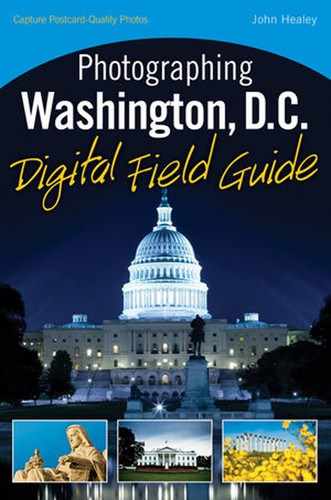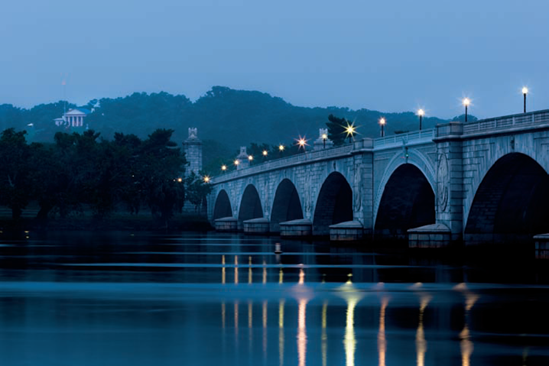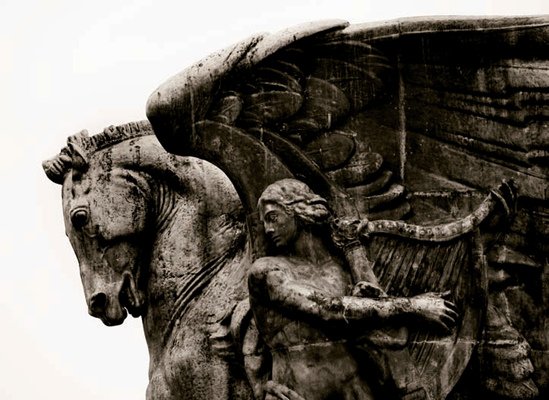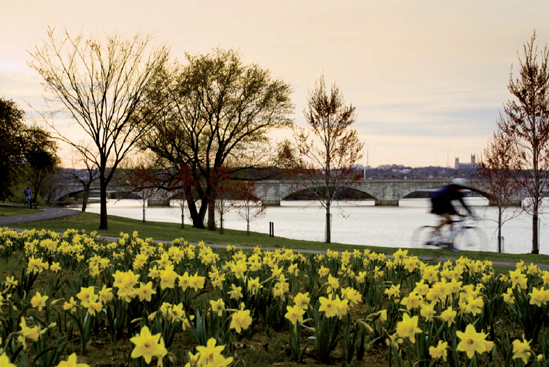
Arlington Memorial Bridge photographed from along the west bank of the Potomac River in Lady Bird Johnson Park. Taken at ISO 200, f/9, 1/40 second with a 75mm lens.
Of the many bridges that span the Potomac River near Washington, D.C., Arlington Memorial Bridge is often considered the most beautiful. It's a symbolic link that draws together the Union's Lincoln Memorial and the Confederacy's Robert E. Lee Memorial across the Potomac, the Civil War-era water boundary between the North and the South.
There are at least three ways to get great shots of Arlington Memorial Bridge: from next to the bridge's east end, from the west end of the bridge, and from the western banks of the Potomac River.
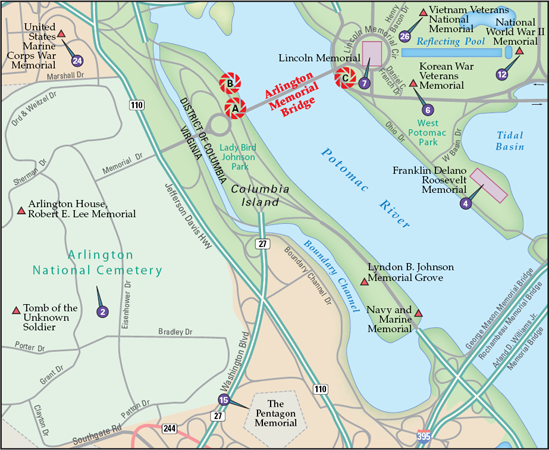
Figure 1.1. The best locations from which to photograph Arlington Memorial Bridge: (A) the west end, north side of the bridge, (B) the west bank of the Potomac River, north of the bridge, and (C) the east end, south side of the bridge. Nearby photo ops: (2) Arlington National Cemetery, (4) Franklin Delano Roosevelt Memorial, (6) Korean War Veterans Memorial, (7) Lincoln Memorial, (12) National World War II Memorial, (15) Pentagon Memorial, (24) United States Marine Corps War Memorial, and (26) the Vietnam Veterans National Memorial.
The view from the bridge's west end and on its north side lets you line up the Lincoln Memorial with the bridge (see Figure 1.1). One way to get to this point is to walk from the Lincoln Memorial across the north sidewalk of the bridge and then follow a dirt path down and around to its north side, immediately after the end of the bridge. Another option is to park at Arlington National Cemetery, but you will have to work around its parking hours to do so.
You can also shoot from the banks of the Potomac and get a wider shot with Arlington Memorial Bridge, the Lincoln Memorial, and the Washington Monument all in the same image (see Figure 1.2). One way to get to this spot is from Arlington National Cemetery. Take the sidewalk on the south side of Memorial Drive and follow it toward the Potomac.
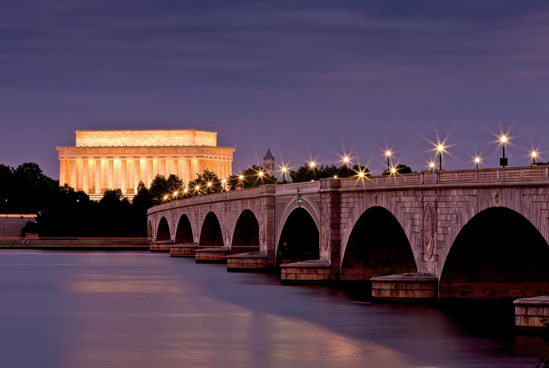
Figure 1.2. Arlington Memorial Bridge photographed from the Virginia side at dusk (see A on the map). Taken at ISO 100, f/16, 30 seconds with a 150mm lens mounted on a tripod.

Figure 1.3. The view from the banks of the Potomac River on the west side of the Potomac River on a summer evening (see B on the map). Taken at ISO 640, f/5, 1/100 second with a 90mm lens mounted on a tripod.
Turn right where it tees and follow it to the Mt. Vernon Trail, where you'll head north. One other option is to park at Theodore Roosevelt Island's parking lot along the Potomac (north of the bridge) and walk about 3/4 of a mile southeast on the paved trail.
On the east end of Arlington Memorial Bridge, you can shoot from the south side of the bridge (see Figure 1.3). A grassy hill overlooks the river, making a nice spot to photograph the bridge with the Arlington House in the background. Getting to this spot is easiest from the Lincoln Memorial area using the crosswalk from its south side.
You can also access it by walking from the parking lot at Arlington National Cemetery and then across the south span of the bridge.
These photos require a little bit of hiking and finding places to shoot that are off the beaten path. It's a good idea to pack lightly, wear some good shoes, and bring some water. Although the locations are close together, you will have to do some walking because access is limited.
All of these locations require moderate to longer telephoto lenses. Flashes and wide-angle lenses can stay at home. If it could rain, bring something to protect you and your gear as well.
For both shots looking across the spans of the bridge (refer to figures 1.1 and 1.3), lenses of between 135–200mm are appropriate, depending on how you choose to compose the shot. From the banks of the Potomac (refer to Figure 1.2), something around 65–100mm, depending on where you are standing, lets you get the Lincoln, Washington, and Arlington Memorial Bridge in the photograph.
A polarizing filter can add some drama to a blue, daylight sky, and a graduated neutral density filter can even out the exposure of the sky depending on the time of day you are shooting.
A tripod is helpful to do an early morning or dusk shot at any of these locations, but you could shoot them handheld if you feel your hands are steady enough. (Shooting below 1/30 second hand held is usually not recommended.)
Tip
If you are using a tripod and long exposures, use your camera's self timer to trip the shutter to avoid hand-shake.
Camera settings vary widely depending on the time of day that you shoot. However, a few things are constant. If you are shooting in the warm morning or evening sun, set your camera's white balance to its Sun mode to render the light best. Higher apertures allow you to get the entire bridge in focus but also mean slower shutter speeds and/or higher ISO settings.
If you're not using a tripod, focus on the most distant subject and set a lower aperture value, since having the bridge in complete focus isn't absolutely critical depending on your composition. Doing so allows you to hand hold your camera rather than use a tripod.
The best images of the bridge are made morning or evening, but during the day can also work as well.
For the shots from the north side of the bridge (refer to figures 1.1 and 1.2), evening is your best bet. The sun fills up the spans of the bridge and creates an orange-yellow aura within them, while the Lincoln Memorial and Washington Monument glow under its light.
For the shot from the east (refer to Figure 1.3), the morning sun will light the bridge and Arlington House.
These photographs are all of outdoor areas that offer no protection in case of rain. While the classic images are summertime, sunlit shots, shooting in other conditions such as overcast skies, snow, and fog can be equally powerful. Overcast skies offer soft light that make for good black-and-white photos, for example. Make the best of what you are given with the time you have and remember that surprises can be the best part of photography.
These shots work best while some ambient light is in the sky. At night, you may need a full moon to help get some light under the spans of the bridge so that you can tell what the structure is.
The spans of the Arlington Memorial Bridge positively glow when the early morning and evening sunlight are upon them, and the picture possibilities here are great. Also, keep an eye out for rowers, kayakers, and other boats. They can give the bridge an awesome sense of scale. Consider photographing all the architectural details and statues at either end of the bridge as well (see Figure 1.4).
